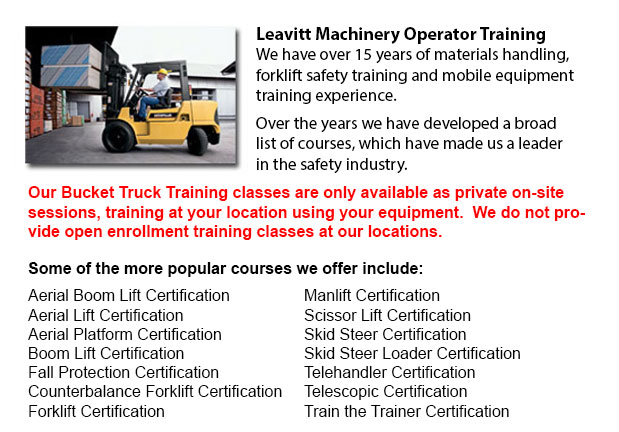
Warehouse Forklift Safety Training Vancouver - Companies normally face liability for injuries and damage sustained in workplace accidents. Warehouses could be hazardous places to the individuals who work there. That is why employee safety is a top priority for a lot of businesses. Warehouse safety training is one of the most effective ways to protect staff, while minimizing expenses associated with accidents and injuries.
The warehouse holds large amounts of stock and materials which could pose dangers, especially when these are being moved. The transporting of stock utilizing a powered machinery or by hand can cause injuries the employees' hands, fingers, feet and toes. Tripping, falling and slipping are common reasons for injury. Heavy things could fall off shelves and harm workers. Forklifts and other machines carry inherent hazards as they manipulate heavily laden pallets. Wrong lifting is a common source of back injuries. Even nails, splinters and box cutters could lead to harm.
Warehouse conditions can change from one moment to the next, depending on the substances or materials being handling, the job being carried out and the equipment being used. Due to the different potential hazards in warehouse settings, warehouse operations are regulated by many various standards. There are regulations for material handling and storage, for walking and working surfaces, and regulations governing the use and selection of PPE (personal protective equipment).
Many warehouse safety rules are common sense. Here are some examples of warehouse regulations all employees should be familiar with:
1. When working in a warehouse, safety is a priority at all times.
2. PPE, like for example safety shoes, gloves, eye protection and hard hats, should be worn as appropriate.
3. Possible hazards must be checked and reported.
4. Understand warning signals and signs - and follow them.
5. Watch where you're going and focus on what you're doing.
6. Pay attention to what others are performing nearby - specially forklifts and other hazardous equipment.
7. Store and stack materials so that they're stable and secure.
To be able to guarantee a safe warehouse, workers must adhere to good housekeeping rules. Basic regulations for housekeeping involves keeping the aisles and floors clear of objects like for example wires and cords. Never perch things insecurely on a surface. When spills take place, clean up immediately. Dispose of trash in proper containers. Keep fire exits, fire extinguishers and sprinklers accessible. Put box cutters and other sharp tools away immediately after using. Report tripping hazards like for example damaged or loose flooring.
-
Telehandler Ticket Vancouver
Telehandler Ticket Vancouver - The telescopic handler or telehandler is a frequently used equipment in agricultural and industrial applications. This equipment is similar in appearance to a forklift and also functions in a similar way, even if teleha... More -
Forklift Operator Certification Vancouver
Forklift Operator Certification Vancouver - Forklift operator certification is usually needed for employees working within industrial, warehouse or construction environments to guarantee the safe operation of forklifts. Workplace training need to fol... More -
Certified Fall Protection Training in Vancouver
There are high numbers of injuries at work linked to falling and a lot of fall-related deaths reported each and every year. The majority of these instances might have been avoided with better training, better measures in place, and by correctly equip... More -
Forklift Training Course Vancouver
Forklift Training Course Vancouver - CSA and OSHA establish criteria for forklift safety training which meets existing standards and regulations. Anyone planning to utilize a forklift is needed to successfully complete safety training prior to using... More -
Overhead Crane Certification Vancouver
Overhead Crane Certification Vancouver - The overhead crane certification course is a program that is designed to assist trainees, even if they have literacy or language restrictions. The course comprises a practical hands-on training session and a c... More -
Forklift Instructor Training Vancouver
Forklift Instructor Training Vancouver - Forklift Instructor training certification is recommended for forklift operators who would like to become instructors. To qualify for forklift instructor training, operators must be able to prove they possess... More -
Crane / Overhead Crane / Truck Mounted Crane / Hydraulic Cranes Training in Vancouver
Overhead cranes are likewise referred to as bridge cranes. They are actually a type of crane which comprises a hook and line apparatus which runs along a horizontal beam which runs along two widely separated rails. Lots of overhead cranes can be foun... More -
Scissor Lift Safety Training Vancouver
Scissor Lift Safety Training Vancouver - A scissor lift is a kind of platform lift that moves vertically. The lift table is moved in a vertical motion because of criss-cross folding supports which are linked in what is referred to as a pantograph. Th... More

Forklift Training Vancouver
TOLL FREE: 1-888-254-6157
24389 Fraser Highway
Langley, British Columbia
forklifttrainingvancouver.com
Email Us
About Us


